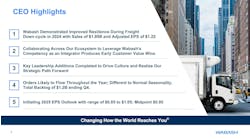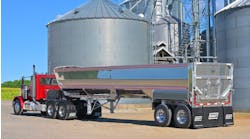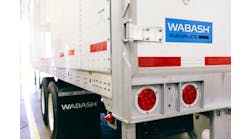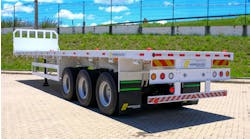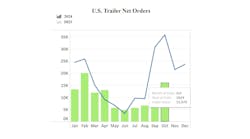The future of commerce is electronic, and dealers, OEMs and suppliers who aren’t fully invested online are out of luck
Dave Durand spent 40 years in the trailer industry, most recently as vice president of aftermarket for Great Dane Trailers, before retiring in April.
Now he’s determined to give back to the industry he says gave him so much.
That mission led Durand to passionately plea with dealers, original equipment manufacturers (OEMs) and suppliers to accelerate their electronic commerce strategies during his presentation “Dealership E-Commerce Challenges and Opportunities” at the 29th Annual National Trailer Dealers Association (NTDA) Convention.
Durand discussed e-commerce trends and basics; types of e-commerce, and where the greatest opportunity lies; the importance of comprehensive dealership management systems (DMSs), and their ability to integrate all aspects of a business and link to third parties; and ways in which trailer industry manufacturers and suppliers can help bring dealers and their customers into the brave new world of digital sales.
“I really believe the health of our businesses, and our industry, depends on this,” Durand said. “We all have sales challenges in our business, whether its trailers, parts or service, and more and more as we go down the road, those sales challenges are going to be magnified by electronic competitors if we’re not engaged in this.”
The background
By definition, e-commerce is activity related to buying or selling products or services online, which Durand said probably is the best way to engage customers now, and certainly going forward, while also strengthening relationships and building loyalty.
For Durand, and folks in the trailer industry, e-commerce also involves sending and receiving payments and orders, and sharing critical information and data.
The most common types of e-commerce are business-to-consumer (B2C)—think Amazon with its vast distribution network—consumer-to-consumer (C2C), which includes a good chunk of the electronic marketplace, like eBay, which enables individual buying, selling and bartering; and business-to-business (B2B), which, for a truck or trailer dealer, typically involves an online portal for buying from an original equipment supplier (OES).
Durand maintains the greatest e-commerce opportunities for dealers are in B2B interactions.
“It’s one thing to have a B2C site, where you’re out there competing with the entire planet … and a totally different setup to think about going down the road of business-to-business, where you already own that relationship with the customer, and you have that business-to-business relationship with that customer electronically,” he said. “This is our greatest opportunity.”
Improved and expanded B2B interactions with customers are critical to the continued success of the North American trailer industry because they’re already occurring elsewhere—the auto aftermarket and heavy-duty trucks are big players in this space—and trailer OEMs and dealer networks aren’t keeping up with the Joneses.
“It hasn’t hit us yet,” Durand said. “We haven’t adopted, we haven’t moved in that direction, for the most part, as an industry, and this is our biggest challenge. We need to get up to speed and get going in that direction.”
Why? Follow the money. Based on US Commerce Department figures, e-commerce was worth $517 billion in 2018, representing 14.3% of all retails sales—or nearly 2½ times more than the online share only eight years ago. Digital sales were up 15% year-over-year in 2018, and are averaging 12% to 16% growth every year. Those numbers are expected to continue climbing—as brick-and-mortar sales continue to crumble.
The basics
At its core, e-commerce is simply another way for dealers to reach the customer, so don’t overcomplicate the issue, Durand advised. Personal visits still are important, and email, text, social media, phone and fax have their value. B2B is another sales channel in the mix, another way to reach out to the customer.
It’s only growing more important, too, especially in a dealer environment fraught with eroding margins and stagnant or increasing costs—and the cost of the human capital required to manually perform all the tasks in a dealership, Durand said. B2B helps mitigate that cost, not only for dealers, but OEMs, suppliers and technology partners.
So how do dealerships and key personnel prepare to engage in B2B e-commerce? First, Durand cautioned, recognize the need for digital adoption, especially at the back end of the business, which ultimately falls on dealer principals to be a driving force. Second, don’t bog down in the details, and deciphering the terms and electronics. It’s not important to know how it all works, only that it does, so embrace the change.
“You’re comfortable with what you’re doing, but it’s going to kill you, so get a little uncomfortable, figure it out and move forward with it,” Durand said. “Because that comfort is a deadly disease, and not wanting to change is deadlier.”
The most important ingredient in a successful e-commerce strategy is a capable dealer management system (DMS). This should be the foundation for all dealership activity, Durand said. A good DMS primarily is transactional, dealing in financial reporting and accounting, and capturing all activity related to parts sales, trailer sales, service, and rents or leases, and connects all the dealer’s departments and branches.
Once the dealership has adopted a DMS, use it. One provider estimates they see only a 40% to 50% usage rate of its systems in service, meaning these tools aren’t being fully utilized. And, most importantly, change how systems are viewed. The DMS itself, or any other software, is not the asset, especially when it’s 10 years out of date. The data and the information inside the DMS are the real treasure trove.
“Until we reverse that (thinking), and start looking at that data and that information as the asset, and the DMS as the expense, we’ve got a problem,” Durand said.
The bonuses
Durand mentioned four of the largest providers, who own approximately 80% of the truck dealership DMS market combined: Karmak—a longtime National Truck Equipment Association member—Procede Software, DSI Solutions and CDK Global. Durand said he sees them on the trailer side, too, but at last check, 70% of trailer dealers weren’t using one of these platforms.
All four boast another key feature—the ability to add on other software modules for managing different aspects of the dealership with greater precision, whether its new or used trailer sales, parts sales or otherwise. Record360 for used trailer sales allows customers to go online with the dealer, see key information, and puts everything the customer needs to know right in front of them, accessible at the click of a button.
WHI Solutions offers add-on parts software that works well, Durand said. The company owns 80% of the auto aftermarket space in B2B e-commerce and now is moving into heavy-duty sales, serving as the primary platform for companies like VIPAR Heavy Duty. Their product connects to the dealer’s DMS, and links the DMS to the customer, while also providing the option for putting parts in a B2C environment through parent company eBay.
Service event management (SEM) software is included in many DMS systems, but Decisiv is a third-party technology provider with excellent, mobile-equipped platforms, 30,000 users and extensive DMS connectivity. A customer relationship management (CRM) module is another valuable add-on dealers can use as a touchpoint app with customers, providing them with the ability to access all of their information the dealership possesses.
Just make sure it can link. “Linking,” by Durand’s definition, is system-to-system electronic data and information transmission with no human intervention required. The DMS, and all internal systems and add-on software, must be able to link together, and to outside technology partners, suppliers, OEMs and OES groups. If a prospective technology provider says their systems don’t link to any of these, go elsewhere.
“You want your systems to talk to each other,” Durand said. “Think for a minute about the time savings created here. Go through your backend departments and frontend departments and look at the time people spend exchanging data and information manually, manually keying something in. You buy 100 trailers from the OEM and you’ve got somebody in your new trailer department keying in the specs into your QuickBooks, right? That’s got to stop. That’s killing you. It’s got to be connected, those trailers hit the dock, they’re in your system, boom—push of a button. That’s where we need to go.”
The four types of links are electronic data interchange (EDI), file transfer protocol (FTP), WebRTC real-time web communication, or “web calls,” and application protocol interface (API), which is a direct, integrated connection. The first two are not real-time connections and the second two are, so they are preferred, Durand advised.
The buildup
Dealers may struggle to implement all these digital tools without help. This is where OEMs and suppliers can, and should, step in, Durand insisted. Dealers need to be able to see and process key information and data, quickly and efficiently, like pricing, MSDS sheets, warranty information, 360-degree views, specs, comparisons, build data, installation instructions, parts breakdowns, and on and on, so make that information digitally available, if not on the dealer’s DMS, than through a web call or other link that promotes e-commerce—and benefits every business along the supply chain.
“(OEMs and suppliers) ought to consider hosting some of these programs and software, because, No. 1, they enhance the fleet relationship,” Durand said. “They link the OEM, the dealer and the fleet together, so some of these software and programs have great benefits for the OEMs. I believe it strengthens relationships across all the channels, provides the dealer network a competitive advantage, it returns useful data … and in a lot of cases the cost to the dealership on their own is prohibitive.”
A few examples of hosted systems and programs for OEMs and suppliers are national account parts and service programs, parts e-commerce platforms, SEMs, data repositories, product information management systems, and new and used trailer sales software.
“The easier you are to do business with, the more margin control you have, and the more margin control you can exercise,” Durand said.
